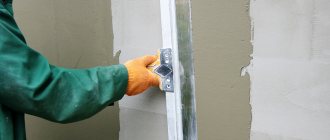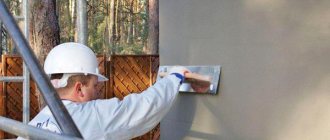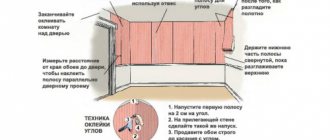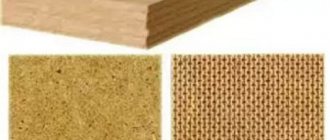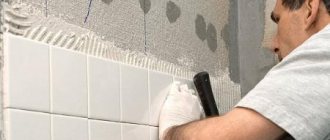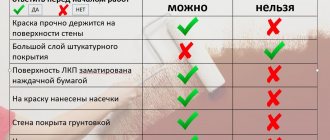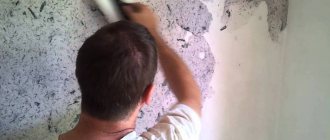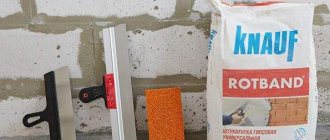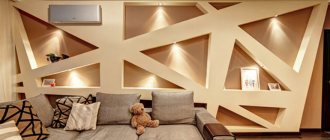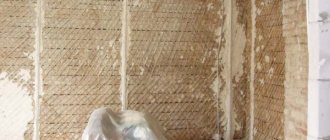Many people use this mixture to speed up the work process, but this is not correct. When cement is added to gypsum plaster, it begins to dry faster, which speeds up the work. But after applying plaster to the walls, after a few days it begins to crack, small cracks form, which is not acceptable for high-quality work.
If you add another layer on top of such plaster, the cracks will become even larger and then you will have to start all over again. If you mix gypsum plaster with cement, you will eventually have to clean the walls and apply a new layer of one material. It is best to perform gypsum plaster separately and cement-based plaster separately. In this case, the plaster will last longer than if the solution is diluted. To improve the quality of the composition, you can resort to special additives to gypsum plasters:
- special plasticizers;
- anti-adhesive agents;
- primers, etc.
I can answer this question unequivocally; it is impossible to add gypsum to cement mortar, even in small quantities. Although they say that when producing cement into clinker, this is an intermediate product, a small amount of gypsum is added, one or two percent, but I’m not strong in chemistry, I don’t know. But I have extensive experience in plastering with cement-sand mortar with the addition of gypsum.
I even had to work for such unscrupulous foremen who, apart from this “sinister mixture,” did not work with anything else. Why is this necessary? The speed of work increases five to ten times, and as you know, the faster you hand over an object, the faster you receive money. And don’t think that only small private owners are guilty of this.
The plaster layer made with a cement-gypsum mixture after some time of one to five days, depending on the base, begins to become covered with a web of very small cracks, they can be noticed if the surface is well primed with a primer.
You can putty and forget only if the base is made of red brick and the plastering work was carried out indoors. But in most cases, gypsum is added to cement when plastering concrete bases; on red brick, plaster sets quite quickly even without gypsum.
For facade
If you need to plaster the walls inside, then you can use the same compositions, just change the proportions. Follow the link to read what warm plaster for exterior use is.
Cement
First you need to prepare the sand and sift it thoroughly. The purer this material is, the easier it is to carry out repair work. After this, you can begin the process of preparing the solution. Here it is worth observing the following proportion: cement M400: sand - 1:4. If you use M50, then the proportion is different: 1:5.
The presented proportions must be observed exactly, otherwise the prepared solution will be fragile. First you need to combine the dry ingredients, and then slowly add water to the container. As a result, you should get a solution whose consistency will resemble thick sour cream. It is advisable to carry out the mixing process using a concrete mixer or construction mixer. It all depends on the volume of construction work
Lime
There are situations when lime is used instead of cement to produce plaster. It should be immediately noted that this will not affect the quality of the finished product at all. It is slaked lime that needs to be used here. If there is no such ingredient, then, using a large container, you can perform the quenching process yourself.
Types and features of putty compositions
Gypsum putty is a paste or powder mixture, its base is gypsum.
The material includes:
- Snow-white gypsum , but many domestic manufacturers use gypsum available in local deposits, which is characterized by a yellowish tint.
- Modified polymer water-soluble additives.
- Modifiers and plasticizers . These components protect the solution, after coating it on the walls, from premature drying and then crumbling, and protect them from cracking.
- Mineral fillers. It can be:
- marble flour. It has very small fractional particle sizes of fractions of a millimeter;
- white quartz sand.
The size of the fractions of these elements determines the characteristics of applying the composition: with a decrease in the size of the filler particles, a thinner layer of plaster is applied to the surface to be finished.
The size of the filler particles allows the putty to be classified into:
- Starter (see Starter putty for walls: types, purpose, application). This type of material rather refers to plaster mixtures, and is intended for leveling and smoothing the plaster layer.
- Finishing (see Finishing putty for finishing). With its help, a thin leveling layer is created on even flat surfaces.
- Universal gypsum putty. In addition to the minimum particle sizes, the material is distinguished by the peculiarities of the binder base with gypsum, which is used in its composition. These unique characteristics allow the application of a thick layer of plaster. With it you can:
- seal joints between plasterboard boards;
- seal cracks and deformations;
- Pre-plaster concrete surfaces.
Gypsum plaster: characteristics and applications
Photo from the site: GidPoPlitke.ru
Most often, compositions containing gypsum are sold in construction stores in the form of dry mixtures, to which all the necessary components have already been added in advance, from the gypsum powder itself to plasticizers, which significantly reduce the drying time. Such mixtures simply need to be diluted with water and can be immediately applied to a previously prepared surface. Many people are interested in the question of whether it is possible to apply gypsum plaster on cement plaster and the answer is definitely positive, since it really provides high-quality adhesion to almost any surface, which is what attracts most buyers.
By applying gypsum compounds, a perfectly smooth surface can be obtained immediately, from the first, rather thin layer. This type of finishing is applied both manually and by machine, which greatly facilitates and even speeds up the process. However, this type of plaster is not always suitable, for example, for excessively wet rooms, such as bathrooms, it is better not to use it, and external walls are not the best place for gypsum, which is quite hygroscopic.
Advantages of gypsum compositions
Photo from the site: GidPoPlitke.ru
Unlike cement, gypsum has twice as many useful qualities and properties, which must be taken into account when choosing. First of all, it is the safety and environmental cleanliness of the substance. Cement is still dangerous to human health until it has completely set; such risks certainly do not exist. But how else does gypsum plaster differ from cement plaster and what advantages does it have?
- Gypsum plaster is quite light; it cannot put such a load on the walls that they cannot withstand it, like heavy-duty cement compounds. This allows you to reduce the actual mixture consumption per square meter, which saves budget funds.
- Such compositions do not shrink, which prevents cracks from occurring on the surface.
- Walls finished with gypsum plaster retain heat quite well, they are never completely icy, and gypsum insulation from external noise is much better.
- By its nature, gypsum has a porous structure, which allows the walls to “breathe”, which ensures freer movement of air and steam, preventing dampness from entering the house and causing black mold and mildew, which are very dangerous for humans.
- Gypsum-containing compositions are very plastic, they have excellent adhesion to almost any surface, dry quickly and allow the alternate application of several layers, the creation of shaped and protruding parts, textured surfaces and similar decor.
Is it possible to apply cement plaster to gypsum plaster? On what substrates is plaster applied?
Each type of plaster exhibits good adhesion to certain substrates.
- Cement-lime
Suitable for exterior and interior decoration, including surfaces with high humidity or temperature extremes. The lime in the composition makes the solution plastic.
Cement-lime plaster is well applied and lasts a long time on brickwork, monolithic concrete, cement-bonded and asbestos-cement boards (CSB and ADC), wood, chipboard and OSB. It can also be installed over durable old paint and tiles.
- Plaster
The best option for finishing in heated rooms. The plaster has good heat and sound insulation, is plastic and easy to use. Gypsum plaster is applied to brick, monolithic concrete, masonry made of cellular and lightweight concrete, DSP and ADC boards, wood, chipboard and OSB. If the old paint or tiles are holding up well, this material can also be applied over them.
- Decorative plaster
Decorative plaster is plastic, quickly gains strength, and after drying it forms a vapor-permeable layer that does not crack. Suitable for use inside and outside the building, including in rooms with high humidity. It is possible to choose between acrylic, mineral, silicate or silicone plaster.
This material is applied to surfaces made of monolithic concrete, masonry made of aerated concrete blocks, and a wall covered with cement plaster. It is also applied to plasterboard (GKL), gypsum fiber sheets (GVL), glass-magnesium sheets (SML), DSP and ADC.
Cost of work
If plastering the walls will be carried out by professionals, you should take into account the approximate prices for such operations:
- manual leveling of the surface with plaster – 350-400 rub/m²;
- manual leveling of walls with cement - approximately 500 rubles/m²;
- plastering walls with cement mortar with reinforcement – 570-640 rubles/m²;
- mechanized finishing of walls with gypsum plaster – from 225 rubles/m².
Depending on the amount of work, the cost may be slightly cheaper or more expensive. However, in any case, leveling with plaster will be cheaper.
Base Compatible
When choosing the type of plaster, pay attention to its adhesive qualities:
- gypsum solution. Adheses well to many materials;
- cement plaster. The list of surfaces with which it has good adhesion is limited. Cement does not adhere particularly tightly to wooden, concrete or painted surfaces. Additional measures help improve the quality of adhesion, but they are generally not friendly with plasterboard sheets, as well as cellular concrete.
Gypsum plaster has more variations in compatibility with a variety of wall building materials than CPR.
Specifications
The quality of mixtures using gypsum binder is regulated by GOST 31377-2008 . According to this document, the main indicators of dry material include:
- humidity: moisture content is allowed no more than 0.30% of the total mass;
- maximum size of granules (grains);
- volumetric weight: 800-1100 kg/m3 (loose) and 1250-1450 kg/m3 (compacted).
Properties of the prepared solutions:
- water consumption when mixing - 0.6-0.65 l/kg
- mobility: the ability to spread under the influence of its own weight; according to GOST 31376, the diameter of the melted sample of the prepared solution (~600 g) should not exceed 165 mm (±5);
- setting time - at least 90 minutes for machine-applied mixtures and 45 minutes for manual plastering;
- complete drying time - after 5-7 days; this indicator depends on the additives in the mixture and differs among different manufacturers; You can find out exactly how long it takes for the plaster to dry in the instructions on the package;
- ability to retain moisture without allowing it to drain: at least 90%;
- consumption for a layer of 10 mm is 8.5-10 kg/m2 (manual application) and 7.5-9 kg/m2 (machine application).
Properties of gypsum plaster in hardened form:
- compressive strength - 2.5 MPa;
- surface adhesion force - 0.3 MPa;
- density - 950 kg/m3;
- vapor permeability - 0.11-0.14 mg/ppa;
- thermal conductivity - 0.25-0.3 W/m*C;
- shrinkage - does not shrink
Although the vapor permeability (the ability to transmit water vapor) of plastered surfaces is not regulated by GOST, it is also an important technical characteristic that determines the scope of application of the plaster.
When purchasing gypsum mixtures, you should pay close attention to their shelf life. Due to their ability to easily absorb moisture, they cannot be stored for longer than 6 months from the date of release. After this period, their properties change, they begin to clump, and high-quality leveling of walls with them becomes problematic. It is also necessary to pay attention to the tightness of the packaging, which protects against excess moisture - you should not purchase plaster in torn bags.
Durability
Plaster compositions do not have strict limits regarding service life. Experts believe that 20-30 years is a pretty good indicator for gypsum and cement materials. However, there are cases where cement finishing from the mid-19th century has been perfectly preserved to this day. Gypsum plaster without obvious catastrophic situations can also last 50 years or more.
We can conclude that according to the durability criterion, gypsum with cement is almost equal .
Material Compatibility
In past times, when there were no modifiers, gypsum was added to the cement-sand composition, which made it possible to obtain a plastic solution with high adhesive properties.
Used for finishing:
- ceilings;
- window slopes;
- door slopes.
A solution of only sand and cement in such areas lasted no more than a year, and gypsum increased this period to 5-7 years, while the adhesive characteristics of the plaster increased.
But the gypsum component did not completely solve the problem, so after this time the plaster gradually fell off. The reason is the development of ettringitis (cement bacillus).
Photo: cement bacillus under a microscope
Only at the end of the last century was it possible to find a way out. Pozzolanic elements, in which silica is the active component, began to be added to the CPR in combination with gypsum. Dust-like substances prevent the manifestation of the cement bacillus:
- trembling;
- flask;
- diatomite;
- acidic blast furnace slag.
As a result, the range of plasters was replenished with a new product - a mixture based on cement and gypsum.
Which is cheaper - gypsum or cement?
The price of any building materials is an important nuance when planning repair work, since the financial costs of materials can be 50-60% of the price of the repair itself. For this reason, cement plaster, which is significantly cheaper than gypsum, is attractive. If you buy dry mixes rather than ready-made plaster, and then prepare the solution yourself, the money savings will be quite good.
If you compare the price of ready-made liquid or dry mixtures, gypsum plaster will still cost more:
- dry plaster – 9.80-15.60 rub. for 1 kg;
- dry cement – 7.80-9.60 rub. for 1 kg.
However, in terms of consumption, the gypsum mixture is more profitable, since it is used economically, but it must be correlated with the costs per m² of area.
If you have a modest budget, you can try to save on cement plaster by purchasing its components (sand, fiberglass, cement), preparing the solution yourself.
Gypsum plasticizers
Manufacturers strongly do not recommend mixing ready-made mixtures with any extraneous additives. After all, an excess of plasticizers can significantly affect the strength of the future surface.
However, at home it is quite possible to make gypsum-based mixtures with your own hands, for example, quite plastic lime-gypsum. But the reaction between gypsum and water occurs quite quickly, so gypsum plaster hardens quickly.
To make a solution convenient to work with, one of the plasticizers must be added to it:
- diluted PVA glue , about 1% of the total volume;
- lime, used as a plasticizer and to increase hardening time;
- Tartaric and citric acid will also slow down setting. Special liquids, for example, Plast Retard PE, can extend the setting time to several hours, prevent cracks and improve the wear resistance of gypsum.
Is it possible to apply bark beetle to an uneven wall?
This question is often asked by customers who want to save money on preparatory work - leveling. The answer is simple - you can
, but the appearance will differ significantly from what the customer saw on the samples.
Interesting materials:
Why is the water faucet humming? Why is the faucet humming? Why does the machine hum when spinning? Why does the steering wheel hum when turning? Why does the toilet hum when the water is flushed? Why is my water heater humming? Why HTML? Why won't HUJI open? Why and where does the oil come from in the air filter housing? Why can't I open some sites?
Grouting and glossing
Grouting is the manual removal of small irregularities, seams, and transitions between layers. Usually they are rubbed down after the plaster has dried. To do this, take a metal or plastic grater. The tool is moistened with water or a primer intended for application after plastering, and the surface is treated with circular or vertical and horizontal movements, periodically clearing the grater of the solution. Particular attention is paid to the corners.
The video above (time 5:35) shows the process of glossing the surface - creating an ideal plane without finishing putty. Glossing and rubbing are very similar methods, using the same tools and techniques. But the difference is that this happens on plaster that has just set and is still wet. This saves time and eliminates the need to apply putty.
Finishing of aligned walls
After applying a layer of plaster, it is necessary to determine how further finishing will take place:
- when preparing walls for painting or thin wallpaper, the surface after grouting is additionally processed with a special tool with a rubber or metal base - a trowel; sticking thick wallpaper for painting does not require such leveling;
- water-based, water-dispersed or acrylic paints are suitable; the walls are puttied, this makes it possible to fill even the smallest voids and cracks; also be sure to prime to increase adhesion, protect the walls and ceiling from shedding and distribute the dye evenly;
- textured and relief plasters fit perfectly on gypsum plasters; the pattern is created with a decorative roller or stamp, improvised means are often used: brushes, brooms, plastic bags - the creation of a unique design is limited only by the imagination and skill of the craftsman;
- especially stands out from decorative plasters - Venetian, colorful glossy surface like marble or granite; it is created in several thin layers, which are tinted in different shades; the effect of a smooth stone is obtained by applying special wax.
As you can see, gypsum mixtures are extremely in demand in finishing and repair work and are used everywhere.
We hope that this article was useful to you and that you found the information you were interested in. Please leave your questions and comments in the comments below.
Previous
Types of plaster Comparing the properties of gypsum and cement plaster: when is it better to choose which one, and can it be mixed?
Next
Types of plasterPreparation of cement mortar for plaster: selection of material, proportions, mixing
Use in damp rooms and outdoors
As we have already mentioned, gypsum plaster is capable of absorbing moisture, so its use in wet rooms and especially for facade finishing is not advisable.
If it is necessary to make the gypsum surface moisture-resistant (for example, when preparing to lay tiles in the bathroom), it is coated with a deep penetration primer based on acrylic. Concrete contact soil is ideal for tiles.
Polymer waterproofing mastic, for example, Plitonit Gidroelast, also has good moisture-proof properties. It is applied on top of a thoroughly dried layer of plaster using a brush or roller in several layers. Each of them must be applied after the previous one has dried. Gluing of tiles is allowed only one day after application. It is recommended to fill the outlets of pipes and corners of various structures with the same mastic.
Wall plastering technology
Now let's look at the basic rules for leveling walls with cement mortar:
The walls are pre-treated with a primer to improve adhesion and dried thoroughly;
To create a plane, beacons - guides - are placed on the wall. In small areas they can be replaced with slaps of mortar, the height of which is adjusted according to the level.
A special metal profile can be used as beacons. It is attached to the wall using putty. You can also make beacons from wooden slats or bars; they are attached to self-tapping screws. The main thing to remember is that the distance between the beacons should be 10-20 cm less than the width of the rule that will be used to level the plaster.
The plaster is applied to the walls with a trowel; to create a layer of greater thickness, you can use a ladle. This first layer is called spray - the basis for subsequent layers.
The second layer should be applied a couple of hours after the first has set . It is placed in the direction from bottom to top, completely covering the previous one. It is more convenient to plaster in small sections of 1-1.5 meters. Then they begin to stretch the plaster and level it with the rule. It is pressed tightly against the beacons and lifted up, while the rule is slightly moved from side to side. Excess mortar is removed from the rule with a trowel.
In this way, they plaster the entire area between the two beacons and move on.
To level small defects, beacons do not need to be used. Plastering in this case is carried out using a different technology. After spraying, the solution is distributed with a large spatula from bottom to top.
A smoother surface can be obtained by additionally covering it with a liquid mixture (second layer). The proportion of the solution in this case will be 1:1 or 1:3 (cement, sand).
After setting, while the cement-sand plaster is not yet hardened, it is rubbed down . Using a grater in a circular motion, remove small irregularities, grooves and protrusions.
The wall leveled in this way, after drying, will be ready for finishing. Cement plaster dries from 4 to 7 days at normal indoor humidity. For facade work, this time can increase to two weeks.
“If you really want to, then you can”
According to building regulations, it is not recommended to apply plaster to a puttied surface. In accordance with the rules of SNiP, plaster can only be applied to a prepared load-bearing base. The regulated order of work is as follows:
- The wall is cleared of all previous finishing - old plaster, paint, whitewash down to the “bare” base. There are technologies that allow plastering over paint and tile adhesive.
- The surface of the wall is thoroughly cleaned of small debris and dust, grease, etc.
- The entire surface to be plastered is treated with a primer. For best effect, the primer should be applied in two or three layers.
- After the primer has completely dried (12 - 24 hours), you can begin applying the plaster mortar to the wall.
Each type of load-bearing base has its own type of soil composition, which should be used for its treatment. This can be a primer for wood, concrete, brick, etc.
As you can see, building regulations do not provide for any plastering of putty surfaces: plaster is intended for finishing load-bearing bases - brick, wood, concrete, clay walls, etc.
Complexity of work
It is much easier to work with gypsum than cement because:
- gypsum plaster does not require preliminary preparation of the walls;
- gypsum can be applied in a maximum of two layers, and when working with cement, at least 3 layers will be required - spray, primer, covering. If you plan to paint the walls, you will need a fourth layer - grout;
Photo: grouting cement plaster
- The gypsum mixture is applied without difficulty and easily adheres to the base. CPR requires physical effort, since you need to rub it in with pressure or throw it on the wall;
- Working with gypsum is easier than working with cement mixture, so it is better for beginners to buy gypsum plaster.
